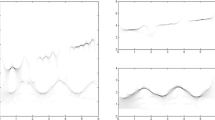Abstract
This is the third in a series of four tutorial papers on biomedical signal processing and concerns the estimation of the power spectrum (PS) and coherence function (CF) od biomedical data. The PS is introduced and its estimation by means of the discrete Fourier transform is considered in terms of the problem of resolution in the frequency domain. The periodogram is introduced and its variance, bias and the effects of windowing and smoothing are considered. The use of the autocovariance function as a stage in power spectral estimation is described and the effects of windows in the autocorrelation domain are compared with the related effects of windows in the original time domain. The concept of coherence is introduced and the many ways in which coherence functions might be estimated are considered.
Similar content being viewed by others
References
Carter, G. C., Knapp, C. H. andNuttall, A. H. (1973) Estimation of the magnitude-squared coherence function via overlapped fast Fourier transform processing.IEEE Trans.,AU-21, 337–344.
Challis, R. E. andKitney, R. I. (1982) The design of digital filters for biomedical signal processing (in three parts). Part 1.J. Biomed. Eng.,4, 267–278.
Challis, R. E. andKitney, R. I. (1983a) The design of digital filters for biomedical signal processing (in three parts). Part 2. —Ibid.,5, 19–30.
Challis, R. E. andKitney, R. I. (1983b) The design of digital filters for biomedical signal processing (in three parts). Part 3. —Ibid.,5, 91–102.
Challis, R. E. andKitney, R. I. (1990) Biomedical signal processing (in four parts). Part 1 Time-domain methods.Med. & Biol. Eng. & Comput.,28, 509–524.
Challis, R. E. andKitney, R. I. (1991) Biomedical signal processing (in four parts). Part 2. The frequency transforms and their inter-relationships. —Ibid.,29, 1–17.
Chatfield, C. (1984)The analysis of time series: an introduction, 3rd edn. Chapman & Hall, London.
Elliott, D. F. andRao, K. R. (1982)Fast transforms, algorithms, analyses, applications. Academic Press, New York.
Jenkins, G. M. andWatts, D. G. (1968)Spectral analysis and its applications. Holden-Day Inc., San Francisco.
Nuttall, A. H. andCarter, G. C. (1981) An approximation to the cumulative distribution function of the magnitude-squared coherence estimate.IEEE Trans. ASSP-29, 932–934.
Oppenheim, A. V. andSchafer, R. W. (1975)Digital signal processing. Prentice Hall, New Jersey.
Tick, L. J. (1967) Estimation of coherency. InSpectral analysis of time series.Harris, B. (Ed.) John Wiley, New York.
Welch, P. D. (1967) The use of fast Fourier transform for the estimation of power spectra: a method based on time averaging over short, modified periodograms.IEEE Trans.,AU-15, 70–73.
Winski, R. W. (1986) Adaptive techniques for signal enhancement in the human electroencephalogram. Ph.D. Thesis, University of Keele, UK.
Bibliography
Benignus, V. A. (1969a) Estimation of the coherence spectrum and its confidence interval using the fast Fourier transform.IEEE Trans.,AU-17, 145–150.
Benignus, V. A. (1969b) Estimation of coherence spectrum of non-Gaussian time series populations. —Ibid.,AU-17, 198–201.
Carter, G. C., Knapp, C. H. andNuttall, A. H. (1973) Estimation of the magnitude-squared coherence function via overlapped fast Fourier transform processing. —Ibid.,AU-21, 337–344.
Carter, G. C. (1980) Bias in magnitude-squared coherence estimation (correspondence). —Ibid.,ASSP-28, 97–98.
Jones, A. G. (1981) Transformed coherence functions of multivariate studies. —Ibid.,ASSP-29, 317–319.
Nuttall, A. H. andCarter, G. C. (1976) Bias of the estimate of magnitude-squared coherence. —Ibid.,ASSP-24, 582–583.
Nuttall, A. H. andCarter, G. C. (1981) An approximation to the cumulative distribution function of the magnitude-squared coherence estimate. —Ibid.,ASSP-29, 932–934.
Pisanenko, V. F. (1973) The retrieval of harmonics from a covariance function.Geophys. J.R. Ast. Soc.,33, 347–366.
Stearns, S. D. (1981) Tests of coherence unbiasing methods.IEEE Trans.,ASSP-29, 321–323.
Tick, L. J. (1967) Estimation of coherency. InSpectral analysis of time series.Harris, B. (Ed.), John Wiley, New York.
Wiener, N. (1930) Generalised harmonic analysis.Acta Math.,55, 117–258.
Winski, R. W. (1986) Adaptive techniques for signal enhancement in the human electroencephalogram. Ph.D. Thesis, University of Keele, UK.
Author information
Authors and Affiliations
Rights and permissions
About this article
Cite this article
Challis, R.E., Kitney, R.I. Biomedical signal processing (in four parts). Med. Biol. Eng. Comput. 29, 225–241 (1991). https://doi.org/10.1007/BF02446704
Received:
Issue Date:
DOI: https://doi.org/10.1007/BF02446704




